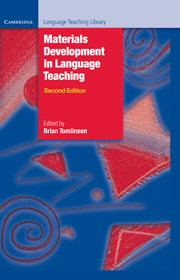Book contents
- Frontmatter
- Contents
- Preface
- Glossary of basic terms for materials development in language teaching
- Acknowledgements
- 1 Introduction: principles and procedures of materials development
- Part A Data collection and materials development
- 2 Using corpora in the language classroom
- 3 Concordances in the classroom without a computer: assembling and exploiting concordances of common words
- 4 Telling tails: grammar, the spoken language and materials development
- Comments on Part A
- Part B The process of materials writing
- 5 A framework for materials writing
- 6 Writing course materials for the world: a great compromise
- 7 How writers write: testimony from authors
- Comments on Part B
- Part C The process of materials evaluation
- 8 The analysis of language teaching materials: inside the Trojan Horse
- 9 Macro- and micro-evaluations of task-based teaching
- 10 What do teachers really want from coursebooks?
- 11 The process of evaluation: a publisher’s view
- Comments on Part C
- Part D The electronic delivery of materials
- 12 Developing language-learning materials with technology
- 13 New technologies to support language learning
- Comments on Part D
- Part E Ideas for materials development
- 14 Seeing what they mean: helping L2 readers to visualise
- 15 Squaring the circle – reconciling materials as constraint with materials as empowerment
- 16 Lozanov and the teaching text
- 17 Access-self materials
- Comments on Part E
- Conclusions
- Recommended reading
- Index
4 - Telling tails: grammar, the spoken language and materials development
Published online by Cambridge University Press: 09 February 2023
- Frontmatter
- Contents
- Preface
- Glossary of basic terms for materials development in language teaching
- Acknowledgements
- 1 Introduction: principles and procedures of materials development
- Part A Data collection and materials development
- 2 Using corpora in the language classroom
- 3 Concordances in the classroom without a computer: assembling and exploiting concordances of common words
- 4 Telling tails: grammar, the spoken language and materials development
- Comments on Part A
- Part B The process of materials writing
- 5 A framework for materials writing
- 6 Writing course materials for the world: a great compromise
- 7 How writers write: testimony from authors
- Comments on Part B
- Part C The process of materials evaluation
- 8 The analysis of language teaching materials: inside the Trojan Horse
- 9 Macro- and micro-evaluations of task-based teaching
- 10 What do teachers really want from coursebooks?
- 11 The process of evaluation: a publisher’s view
- Comments on Part C
- Part D The electronic delivery of materials
- 12 Developing language-learning materials with technology
- 13 New technologies to support language learning
- Comments on Part D
- Part E Ideas for materials development
- 14 Seeing what they mean: helping L2 readers to visualise
- 15 Squaring the circle – reconciling materials as constraint with materials as empowerment
- 16 Lozanov and the teaching text
- 17 Access-self materials
- Comments on Part E
- Conclusions
- Recommended reading
- Index
Summary
Introduction
Descriptions of the English language, and of English grammar in particular, have been largely based on written sources and on written examples. This is inevitable since examples of written English are easier to obtain. One consequence of this situation is, however, that ‘correct grammar’ has come to mean ‘correct grammar as represented by the written language’ and that many perfectly normal and regularly occurring utterances made by standard English speakers (of whatever variety – not just standard British English) have by omission come to be classified as ‘ungrammatical’.
The situation is changing, however, and a number of corpora of spoken English have now been assembled which have allowed more precise description of the properties of spoken English, thus enabling learners of English to become more aware of a wider range of forms and structures than hitherto. With reference to one such corpus this chapter seeks to outline ongoing work in the description of spoken English and to discuss some of the implications for English language teaching, and in particular materials development.
The corpus which will be referred to, the CANCODE corpus, is part of the one-billion-word Cambridge International Corpus (CIC) developed by Cambridge University Press between 1995 and 2010 . The CANCODE corpus was developed between 1995 and 2002 as part of a joint research project between the University of Nottingham and Cambridge University Press (CANCODE stands for Cambridge and Nottingham Corpus of Discourse in English). The CANCODE corpus totals five million words, which is, as far as spoken corpora go, a large corpus – although it is still small compared with many written corpora where 100 million words is a not uncommon size. The main aim, however, was always to construct a qualitative corpus and not simply a large quantitative corpus (for a fuller account of its structure and organisation, see McCarthy 1998). The way the CANCODE corpus is constructed allows very precise contextualised description of grammar, in particular, and its design allows a discourse-based view of language to prevail in descriptions (see Hughes and McCarthy 1998 ; McCarthy and Carter 1994).
- Type
- Chapter
- Information
- Materials Development in Language Teaching , pp. 78 - 100Publisher: Cambridge University PressPrint publication year: 2011
- 3
- Cited by



